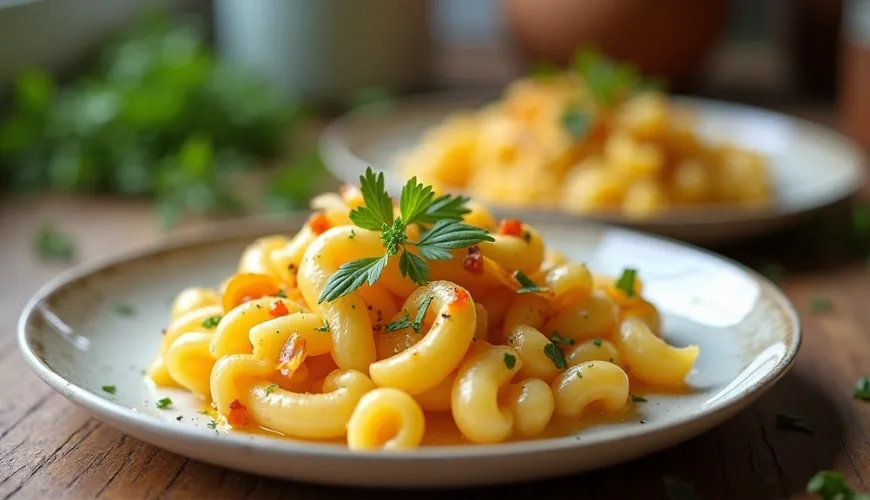
Discover the Magic of Homemade Mac and Cheese and Its Variations

How to Prepare Perfect Mac and Cheese and Why This Cheesy Classic is Popular Even Here
When you mention American cuisine, most people think of burgers, fries, or donuts. However, among the family treasures passed down from generation to generation is a dish that has been gaining increasing popularity here in recent years – mac and cheese, or pasta with cheese sauce. You might be surprised to know that it's not just a quick meal from a box, but a dish you can prepare at home in many tasty and more nutritious variations. Today, we'll introduce a recipe for homemade mac and cheese, appealing not only to lovers of Italian cuisine but also to those seeking convenient, hearty, and sustainable cooking.
From America to the Czech Table
The history of mac and cheese goes back a long way, but its modern form is inextricably linked to American culture. In the 1930s, boxes with a pre-prepared mix of pasta and cheese powder began to be sold in the USA – an affordable and quickly prepared meal, ideal for families in tough times. To this day, this dish has become synonymous with comfort food, a meal that warms the soul and reminds you of childhood.
But with the growing interest in quality ingredients, home cooking, and a healthier approach to the diet, mac and cheese is beginning to return to its roots – homemade preparation with real cheese, butter, milk, and pasta of choice. These "enhanced" cheesy pasta dishes are now conquering Czech kitchens as well.
Basic Mac and Cheese Recipe You'll Love
Preparing mac and cheese at home isn't difficult. Unlike the instant store version, you have control over every ingredient. The base is quality cheese (ideally cheddar), butter, flour, milk, and of course pasta – traditionally macaroni, but you can use other types you have at home.
Ingredients for 4 servings:
- 300 g of short pasta (e.g., elbows, penne, or classic macaroni)
- 2 tablespoons of butter
- 2 tablespoons of all-purpose flour
- 500 ml of whole milk
- 200 g of grated cheddar (or a mix of cheeses – e.g., gouda, edam, parmesan)
- 1 teaspoon of mustard (optional)
- Salt and pepper to taste
- A pinch of nutmeg (recommended)
Instructions:
- Cook the pasta according to the package instructions until al dente. Drain and set aside.
- In a pot over medium heat, melt the butter. Add flour and stir constantly to create a light roux.
- Gradually add milk, stirring thoroughly to avoid lumps. Cook for a few minutes until the sauce thickens.
- Add the grated cheese and stir until completely melted. Season with salt, pepper, nutmeg, and optionally mustard.
- Mix the cooked pasta into the sauce, combine well, and serve. For extra flavor, you can sprinkle more cheese on top and bake for 10 minutes at 200 °C.
And that's it. The result? Creamy, comforting, and utterly addictive food that you can quickly tailor to your taste and pantry supplies.
Variations Kids Will Love
One of the advantages of the homemade mac and cheese recipe is its incredible versatility. If you have children, you can add grated carrots or pumpkin to the mix – not only will you increase the nutritional value, but you'll also achieve a naturally sweeter, delicious taste. Parents will appreciate that even picky kids will eat their portion of vegetables without protest.
For adults, you can add sautéed mushrooms, grilled chicken pieces, broccoli, or even crispy tempeh. If you're avoiding dairy products, there are vegan versions with plant milk and "cheese" made from cashews – perfect for those seeking a lactose-free alternative or wanting to try a more sustainable option.
Mac and Cheese and Sustainable Living? Yes!
You might ask – how can such a hearty, cheesy dish be associated with sustainability? The answer is simple: it depends on your choice of ingredients and approach to cooking. Instead of packaged mixes, you can opt for regionally sourced cheeses, organic milk, or long-lasting plant-based alternatives. You can buy pasta without packaging or from whole grain flour, increasing fiber and nutritional value.
Similarly, you can use foods that might otherwise end up as waste – leftover cheese, excess vegetables, or older milk. In this sense, mac and cheese becomes not only nutritious but also an ethical and considerate dish – precisely what today's responsible consumers are looking for.
Cheesy Pasta in Real Life
One example of mac and cheese becoming a small miracle of home cooking is the story of a young family from Brno. With two small children and work commitments, they were looking for a way to cook quickly and healthily. "Our kids love pasta, but I didn't want to constantly serve cream-based sauces. I tried homemade mac and cheese with added zucchini and sweet potatoes – and it was a hit. Not only did the whole family love it, but we even had leftovers to reheat for lunch the next day," describes Jana, mother of three-year-old Anička and five-year-old Matěj.
This example shows that homemade cheesy pasta isn't just an American fad but a full-fledged and adaptable dish for everyday cooking. Thanks to its simplicity, even those who aren't confident in the kitchen can prepare it.
When Food Brings People Together
Mac and cheese is more than just a dish – it's a symbol of sharing, home comfort, and creativity in the kitchen. It's a meal that allows for experimentation yet offers familiar flavor assurance. It can be prepared minimally or as a gourmet experience with truffles and a parmesan crust. Most importantly, regardless of the "mac and cheese recipe" you choose, it always results in a blend of flavors that brings a smile to your face.
It's no wonder this dish remains popular across generations and continents. In a time when we seek simplicity, honesty, and the joy of cooking, mac and cheese offers exactly what we need – natural ingredients, the warmth of home, and the opportunity to slow down. These are values that will resonate no matter where we are in the world.

